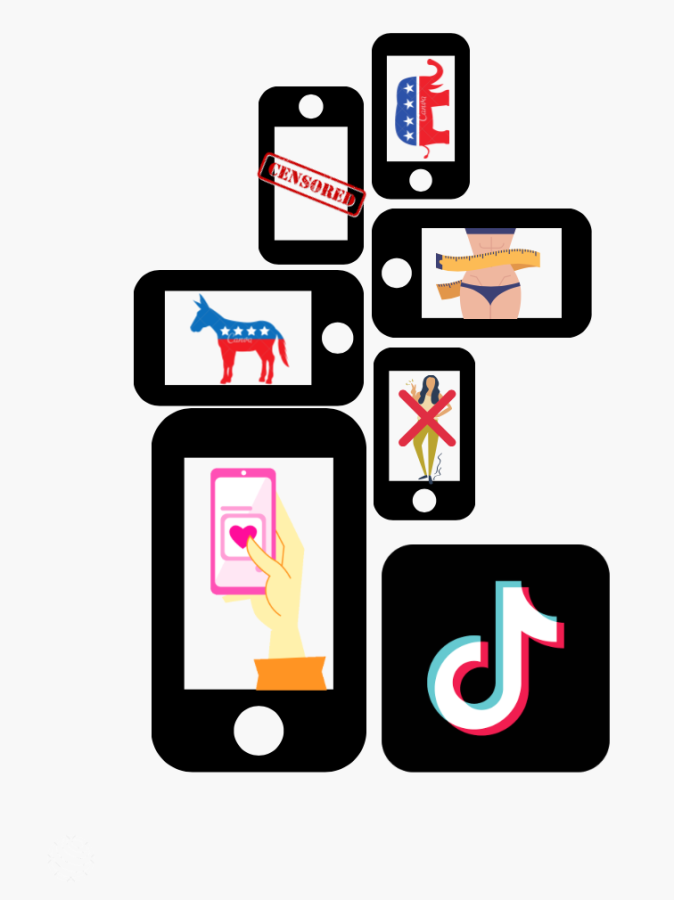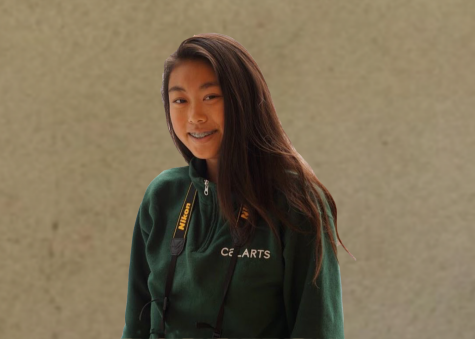The drawbacks of TikTok
Graphic illustration by Katie Chen
Various aspects of TikTok, the social media platform taking the Internet by storm.
November 4, 2020
The past decade has seen platforms like Vine and YouTube become overnight sensations, and the social media app TikTok is no exception. TikTok has become a lucrative platform in pop culture, made apparent through the recent appearances of popular TikTok creators like Charli D’Amelio on late-night television. While TikTok is an effective channel of expression for many, users and creators must recognize that it comes with its drawbacks as well.
Despite creators’ efforts to cultivate a positive atmosphere on the platform, TikTok continues to perpetuate toxic behaviors. It is no stranger to the age-old social media issue of problematic beauty standards. Documents published by The Intercept in Mar. 2020 revealed a troubling slew of censorship by TikTok that involved moderators being told to remove videos featuring users with an “abnormal body shape” who are “chubby… obese or too thin” or who have “ugly facial looks or facial deformities” because “if the character’s appearance is not good, the video will be much less attractive, not worthing [sic] to be recommended to new users.” Instead, many videos feature teens whose physical appearances fall into standards glorified by internet culture — slender hourglass figures, toned bodies, perfectly-done hair and immaculate makeup. Such content is created with the intention of convincing viewers that these physical attributes are natural, but they are often the products of regular physical conditioning, plastic surgery, or image filters. By seeing these stereotypes regularly, adolescents begin to believe that their own physical features are less desirable than others’ when, in fact, many of the TikTok videos they are seeing are a result of appearance-altering practices.
Furthermore, some TikTok content encourages teens to perform certain harmful activities for views, often as part of TikTok “challenges” such as the Outlet Challenge, in which creators record themselves inserting conductive materials into electric wall outlets, and the Skullbreaker Challenge, in which someone is tripped while jumping into the air by two people standing on either side. Although TikTok has made an effort to mitigate the dangers of these videos with warnings, both of these challenges, among others, have led to a number of serious injuries as a result of teens’ naïveté.
“I think clearer ‘kids mode’ settings and more PG options would definitely make the app more kid-friendly since you can’t control what shows up on your For You page and I’ve seen some interesting stuff,” said senior Ria Chaudhary.
Cancel culture, a phenomenon in which public figures are “canceled,” or turned against, for a single action or statement, is equally distressing. Even in comparison to other social media platforms, TikTok’s algorithm allows for videos to go viral rapidly, therefore exacerbating this effect.
“Teens are quick to cancel popular creators for mistakes they made and constantly [bully] them instead of informing and educating,” said junior Arwen Ma.
This occurrence was apparent in the recent backlash against Bella Poarch, a popular TikTokker who revealed her tattoo of the Rising Sun, an offensive symbol for people of Korean descent because of its ties to Japan’s oppressive occupation of Korea. Videos criticizing Poarch blew up on TikTok seemingly overnight, a stark contrast to the constant resharing of her videos prior to the public’s knowledge of her tattoo. Poarch is one of many TikTok creators who has fallen victim to the woes of cancel culture.
Additionally, TikTok has evolved into a hub for political discourse. Although it is certainly important for young people to discuss their political views and to educate themselves on the policies and people who are impacting our nation, TikTok has also enabled the circulation of polarizing and hurtful comments from both the left and right. One such example is Conservative Hype House, which is a TikTok account that glorifies right-leaning views. This is harmful to productive discussion in that it antagonizes those with differing perspectives. It is important for teens to be conscious of these biases in order to work against them and make judgements based on their own research and values, as opposed to pressure from others.
Another problematic component of political content on TikTok is an abundance of misinformation, usually in the form of exaggerations or intentional omissions of certain information in order to make data appear as if it supports one side over the other. Such distortion of facts can sway opinions in one direction and impact the accuracy of understanding of current events.
“The more we hear the same message, the more likely we are to start believing that there’s truth in that message, especially if it’s broadcasted by figures that we admire,” said school psychologist Jenna Starnes. “Always, always fact check with a reliable source, and be aware of how you are being influenced by the repetition of a similar message.”
On top of the aforementioned drawbacks of TikTok, some videos feature inappropriate content that is potentially detrimental to both creators and viewers. A major concern on the app is the sexualization of underage children and teens either of their own volition or through resharing and inappropriate comments from others. Minors who are involved in such content are often unaware of the dangers associated with it, failing to realize that predatory adults or organizations may take advantage of them, posing threats to their safety or mental health. The other prominent category of insensitive content on TikTok consists of videos displaying the death or injury of a person. Recently, TikTok stirred controversy among netizens when it allowed for the widespread circulation of a graphic video in which a TikToker live streamed his suicide. It was later revealed that his mother was one of the thousands of people who watched his death unfold in real-time. To make matters worse, several anonymous TikTok accounts began resharing screen recordings of the suicide or posting videos encouraging gullible viewers to look for the video. Regrettably, TikTok has been made aware of such problematic content but has not been able to effectively censor or remove the videos.
TikTok is both a curse and a blessing for teens. At the end of the day, it is imperative that users remain cognizant of its drawbacks while interacting with the platform to maintain a grasp on reality and to protect themselves from potentially malignant influences.




























































